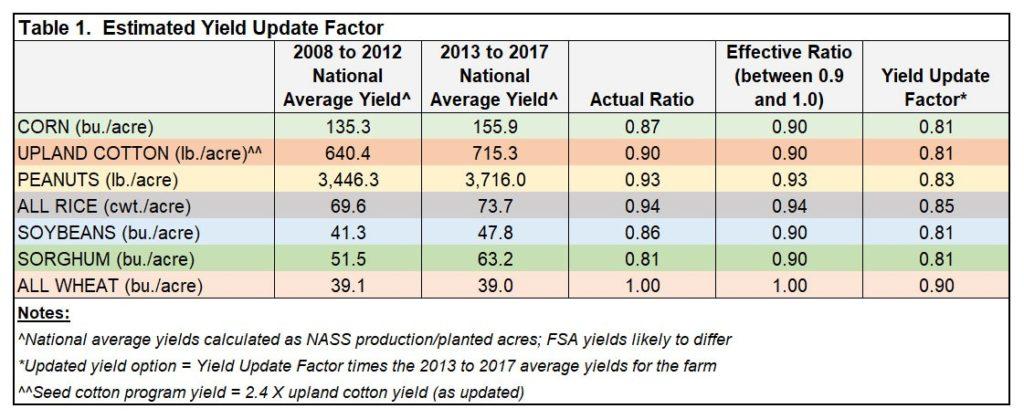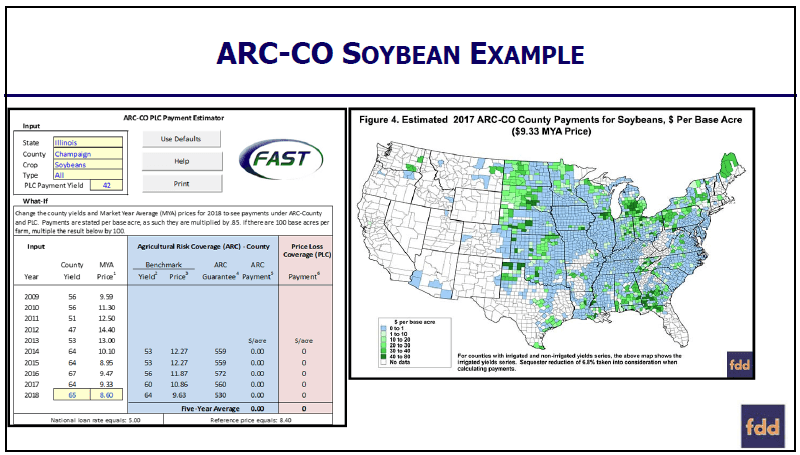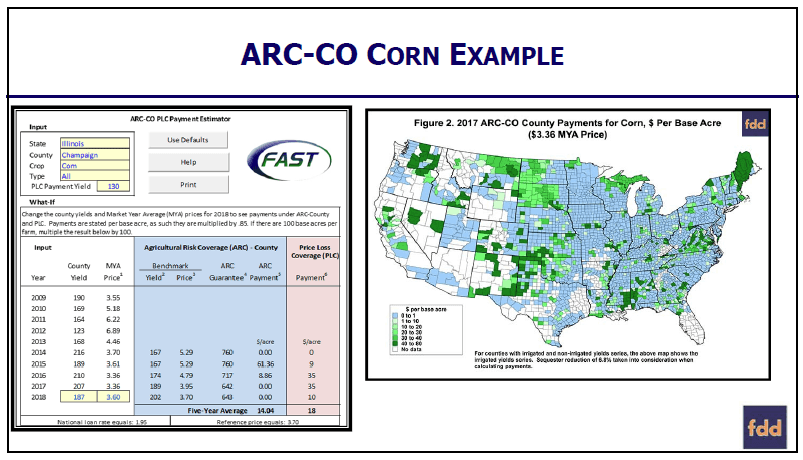Following the long-awaited passage of the Agriculture Improvement Act of 2018 (commonly known as the 2018 New Farm Bill), the $867 billion-dollar bill has set federal agricultural policy for five years. Overall, it continues much of the policies authorized in the 2014 Farm Bill, with no major changes.
While there were no major modifications or surprises included within the intricacies of the new farm bill, there are some notable changes included in the new bill which may affect long-term operational and financial strategies for farmers and ranchers.
K·Coe Isom has outlined the most significant rule changes – affecting Price Loss Coverage, Agriculture Risk Coverage, Conservation, Dairy, and other miscellaneous notables.
Changes Surrounding Price Loss Coverage (PLC) and Agriculture Risk Coverage (ARC)
- Change to Election Year Rules: One of the key changes is from the 2014 bill to the 2018 farm bill is the election between ARC and PLC. In the 2014 Farm Bill it was a one-time election that could not be changed over the five-years of the bill. In the 2018 Farm Bill, however, the election made in 2019 is for the 2019 to 2020 crop years. Beginning with the 2021 crop year, the farmer can change the ARC/PLC election each year. [i]
- Change to PLC Program Yields Option: Farmers are allowed to update PLC program yields, if the increases are greater than a normal trend increase in yields. Owners of an FSA farm will have a one-time option to update their program yields, but the formula is somewhat complicated. It operates in two steps: (1) 90% of the average yield for the 2013 to 2017 crop years, excluding any crop year in which the yield was zero; and (2) reduced by a ratio that compares the 2013 to 2017 national average yields per planted acre to the 2008 to 2012 national average yields.[ii]
Estimate by crop of the expected yield update formula

- Change to Fixed Reference Price Guidelines: Under Price Loss Coverage, fixed reference prices are now allowed to “float” higher based on the Olympic moving average price and may increase to as much as 115% of the statutory reference price. When 85% of the Olympic moving average price is greater than the statutory reference price, support under PLC is increased.[iii]
- Changes to Agriculture Risk Coverage:
- By allowing PLC reference prices to float higher, the plug prices under ARC are also allowed to float. As a result, benchmark prices can be no lower than the maximum of the statutory reference price or 85 percent of the Olympic moving average.
- Risk Management Agency (RMA) date will be used to determine ARC-County Revenue.
- The farm bill changes the plug yield in the ARC benchmark revenue calculation to be no lower than 80 percent of the county’s transitional yield (was 70%).
- USDA Risk Management Agency trend-adjusted yield factors will be incorporated into benchmark and actual yield calculations.[iv]


Notable Changes for Conservation
- Conservation Reserve Program (CRP) acres will be increased: from 24 million to 27 million, but payments will be capped and landowners won’t be able to get extra money to pay for things like planting pollinator habitat.[v]
- Reduced funding: The Conservation Stewardship Program (CSP) remains in place but with reduced funding.[vi]
- Additional funding for EQIP: The Environmental Quality Incentives Program (EQIP) gets a $275 million-per-year boost as Congressional leaders reallocated money from the Conservation Stewardship Program.[vii]
- New water quality initiative: The bill creates within CRP a new water quality initiative focused on clean lakes, estuaries and rivers as a priority for the continuous enrollments, capped at eight million of the overall acres in the program.[viii]
- CRP contract changes: There is a pilot project for 30-year CRP contracts and a shorter-term CRP for soil health and income protection, using three, four, or five year contracts on up to 15% of a field.[ix]
Notable Changes for Dairy
- Margin Protection Program enhanced: The bill builds on enhancements that Congress made to the Margin Protection Program that reduced premiums for the first five million pounds of production, the equivalent of about 240 cows. Producers who have been enrolled in Margin Protection Program in the past would be allowed to get 75 percent of their past premiums refunded if they sign up for the revised program.
Other Significant Changes
- ‘Family Farming Operation’ redefined and expanded: The definition of a family farming operation was changed to include nieces, nephews, and cousins, inside the ownership of an operation, to be considered family members.
- Marketing Loan Gains and Loan Deficiency Payments are no longer included in the ARC’PLC payment limit of $125,000
- 2019 ARC/PLC Election rules changed: If a new ARC/PLC election is not made in 2019, no payments will be made in 2019 and the elections for 2014-2019 will stay in effect.
- Some Grassland/Pasture Base Acres become payment ineligible: Base acres on farms in which all cropland has been certified to grassland or pasture since 2009 will be ineligible for ARC/PLC payments beginning in 2019.
- All grassland and pasture farms removed from the ARC/PLC program will be eligible for a one time, 5-year contract, CSP program.
- Hemp cultivation legalized: The bill legalizes the cultivation of industrial hemp and allocates $10 million for research.[xi]
- Organic research allowance increased: Organic farming received $395 million for organic research, more than double its current amount.[xii]
- Rural broadband gets loans and grants: The bill sets aside $350 million dollars for loans and grants for rural broadband.[xiii]
- Advocate programs for farmers in crisis supported: The bill appropriates $10 million a year to be used for training programs and workshops for advocates who assist farmers in crisis.[xiv]
- Permanent funding approved for:
- Marketing loan rates were increased for all crops other than upland cotton, peanuts and minor oilseeds.[xviii]
For questions surrounding the 2018 Farm Bill changes and their potential effects on your agribusiness’ strategy, contact a K·Coe Isom federal affairs consultant or join us on our webinar.
[i] https://farmdocdaily.illinois.edu/2018/12/the-agriculture-improvement-act-of-2018-initial-review.html
[ii] https://farmdocdaily.illinois.edu/2018/12/the-agriculture-improvement-act-of-2018-initial-review.html
[iii] https://www.fb.org/market-intel/whats-in-title-i-of-the-2018-farm-bill-for-field-crops
[iv] https://www.fb.org/market-intel/whats-in-title-i-of-the-2018-farm-bill-for-field-crops
[v] https://www.mprnews.org/story/2018/12/11/farm-bill-details-released-minnesota-impact-snap-conservation
[vi] https://www.mprnews.org/story/2018/12/11/farm-bill-details-released-minnesota-impact-snap-conservation
[vii] https://www.mprnews.org/story/2018/12/11/farm-bill-details-released-minnesota-impact-snap-conservation
[viii] https://farmdocdaily.illinois.edu/2018/12/the-agriculture-improvement-act-of-2018-initial-review.html
[ix] https://farmdocdaily.illinois.edu/2018/12/the-agriculture-improvement-act-of-2018-initial-review.html
https://www.agri-pulse.com/articles/11708-status-quo-farm-bill-bolsters-dairy-raises-loan-rates
[xi] https://www.forbes.com/sites/bethkaiserman/2018/12/12/farm-bill-moves-to-house/#7dbbd0551bad
[xii] https://www.forbes.com/sites/bethkaiserman/2018/12/12/farm-bill-moves-to-house/#7dbbd0551bad
[xiii] https://www.mprnews.org/story/2018/12/11/farm-bill-details-released-minnesota-impact-snap-conservation
[xiv] https://www.mprnews.org/story/2018/12/11/farm-bill-details-released-minnesota-impact-snap-conservation
[xv] https://www.washingtonpost.com/business/2018/12/11/congresss-billion-farm-bill-is-out-heres-whats-it/?utm_term=.4e0c1bd061ca
[xvi] https://www.washingtonpost.com/business/2018/12/11/congresss-billion-farm-bill-is-out-heres-whats-it/?utm_term=.4e0c1bd061ca
[xvii] https://www.washingtonpost.com/business/2018/12/11/congresss-billion-farm-bill-is-out-heres-whats-it/?utm_term=.4e0c1bd061ca
[xviii] https://www.fb.org/market-intel/whats-in-title-i-of-the-2018-farm-bill-for-field-crops








